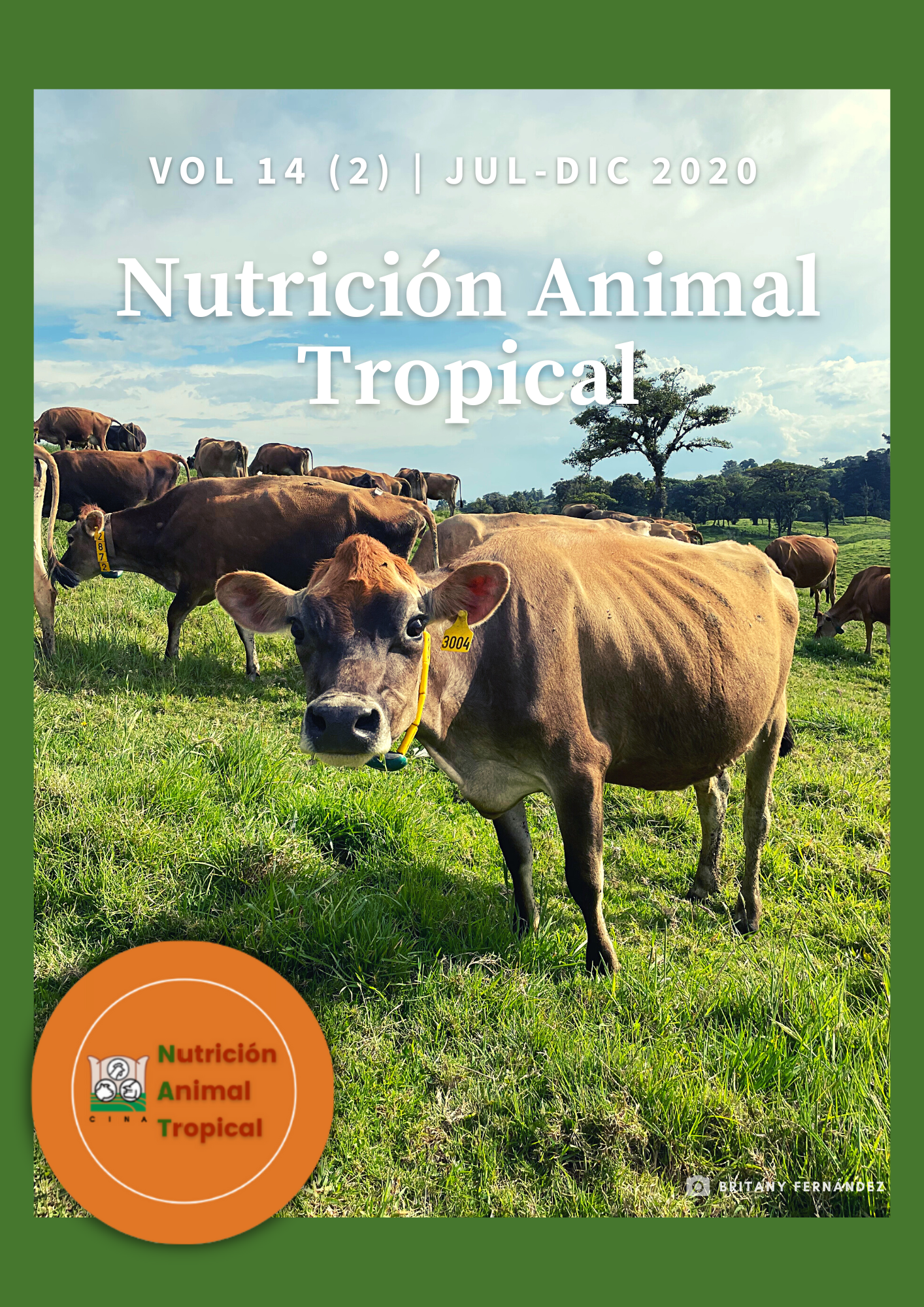Abstract
During the years 2012-2017 Multiovulation and Embryo Transfer (MOET) technique was applied in Holstein and Girolando F1 animals at the Animal Reproduction Unit (URA), of the Escuela de Zootecnia of the University of Costa Rica, with the aim to create and evaluate a Girolando herd in the Costa Rican Atlantic. Female embryo donors were selected at external farms and URA. Selection in external farms was done through the information of breed herd books and farm records, while in URA, through the data of lactation and performance of the offspring. In addition, an estimation of partial costs of embryo production was obtained. URA evaluated animals, as part of the embryo donors selection, showed an average daily milk production of 11.1 kg, with an average lactation length of 296 days, on a single daily milking and with a calf at the cow side. The weaning was carried out at 7 months of age, with an average weight of 255 kg (244 kg for females and 262 kg for males). Overall, in both URA and external farms, 38 collections were done in 24 selected donors, from which 381 structures were collected, 73.5% fertilized and 26.5% unfertilized. From those fertilized structures (embryos), 47.3% were considered transferable (quality 1 and 2 according to the International Society of Embryo Transfer, IETS), for an overall average of 4.8 transferable embryos per collection. 83 fresh embryo transfers and 34 frozen embryo transfers were performed, from which 33.7% (28/83) and 5.9% (2/34) pregnancy rates were obtained, respectively. The low pregnancy rates obtained, compared to literature reports, are not normal results, but are related to this particular study. The production cost of an embryo, due to consumables, hormones and semen was US$62.5 dollars. Production and embryo transfer technique collaborated in the creation and development of the Girolando herd of the Animal Reproduction Unit of the University of Costa Rica.
References
Abdelatty, A.M., M.E. Iwaniuk, S.B. Potts, y A. Gad. 2018. Influenceof maternal nutrition and heat stress onbovineoocyte and embryodevelopment. International JournalVeterinaryScience. Medicine.(6): 1-5.doi: 10.1016/j.ijvsm.2018.01.005.
Bo, G.A., yR.J. Mapletoft. 2013. Evaluation and classificationofbovineembryos. AnimalReproduction10(3): 344-348.Colazo,M.G., yR.J. Mapletoft. 2017. Estado actual y aplicaciones de la transferencia de embriones en bovinos. Ciencias. Veterinarias.9(1): 20-37.
Córdova, A., G. Rodríguez, M. Córdova, C. Córdova, y J. Pérez. 2005. Ganancia diaria y peso al destete en terneros de cruces Bostauruscon Bosindicusen Trópico Húmedo. Medicina Veterinaria y Zootecnia-Córdoba10: (1), 589-592.
CORFOGA. 2017. Precios –CORFOGA –Corporación Ganadera. Consultado el 23 de febrero de 2018 en la dirección http://www.corfoga.org/estadisticas/precios/
Delgado, P.A.M., L.G.R. Calderón, A.M. Aldana, yC.E.L. Penagos. 2012.Desempeño productivo y reproductivo de vacas F1 Gyr x Holstein en clima cálido colombiano. Veterinaria y Zootecnia. 6(1):17-23.
Facó, O., R.N.B. Lôbo, R. MartinsFilho, y A. Moura. 2002. Análise do desempenhoprodutivo de diversos grupos genéticos Holandês x Gir no Brasil. Revista Brasileira de Zootecnia. 31(5):1944-1952.
García, P., L. Quintela, J. Becerra, yA. Peña. 2017. La transferencia de embriones en bovinos. Albéitar Portal Vet. Consultado el 22 de febrero de 2018 en la direcciónhttp://albeitar.portalveterinaria.com/noticia/15991/articulos-rumiantes/la-transferencia-de-embriones-en-bovinos.html
Hasler, J.F. 2010. Bovineembryo transfer: are efficienciesimproving. Appl. ReproStratConferenceNashv. TN.Consultado el 17 de setiembre de 2020 en la direcciónhttps://www.researchgate.net/publication/266421862_Bovine_embryo_transfer_are_efficiencies_improving
Hasler, J.F. 2014. Fortyyearsofembryo transfer in cattle: A reviewfocusingonthejournalTheriogenology, thegrowthoftheindustry in North America, and personal reminisces. Theriogenology 81(1): 152–169.
IMN. 2017. Instituto Meteorológico Nacional, Estación automática de Canta Gallo, Cariari, Limón.Consultado el 17 de noviembre de 2017 en la direcciónhttps://www.imn.ac.cr/especial/estacionCantagallo.html
Jacopini, L.A., S.B.P. Barbosa, D.A.L. Lourenço, yM.V.G.B. da Silva. 2012. Curvas de lactação de vacas Girolandoantravés de diferentes modelos. IX SimpósioBras. Melhor. Anim. PessoaPB 20.
Machaty, Z., J. Peippo, yA. Peter. 2012. Production and manipulationofbovineembryos: Techniques and terminology. Theriogenology78(5): 937–950.
Mandawala, A.A., S.C. Harvey, T.K. Roy, yK.E. Fowler. 2016. Cryopreservationof animal oocytes and embryos: Currentprogress and futureprospects. Theriogenology86(7): 1637–1644. doi: 10.1016/j.theriogenology.2016.07.018.
Mapletoft, R.J. 1985. Embryo Transfer in thecow: General procedures. Rev. Sci. Tech. Off. Int. Epiz. 4 (4): 843-858.Mapletoft, R.J., yG.A. Bó. 2011. Theevolutionofimproved and simplifiedsuperovulationprotocols in cattle. ReproductionFertility andDevelopment. 24(1): 278–283. doi: 10.1071/RD11919.
Molina-Coto, R., C. Arroyo-Oquendo, D. Carballo-Guerrero, y J. Elizondo-Salazar. 2018. Respuesta a la suplementación con propilenglicol en vacas multiovuladas para la producción de embriones. AgronomíaMesoamericana. 29 (3):519-533.
Moore S.G., y J.F. Hasler. 2017. A 100-Year Review: Reproductivetechnologies in dairyscience. JournalofDairyScience. 100(12):10314-10331. doi: 10.3168/jds.2017-13138. PMID: 29153167.
Passini, R., B. de Carvalho Barros, yT.C. Macena. 2014. Teste de tolerânciaao calor em bovinos girolandos cruzados no centro-oeste do Brasil. Acta Vet. Bras.8(3): 163–168.
Phillips, P.E., yM.M. Jahnke. 2016. Embryo Transfer (Techniques, Donors, and Recipients). Vet. Clin. North Am. FoodAnim. Pract.32(2): 365–385. doi: 10.1016/j.cvfa.2016.01.008.SCIJ 2020. Sistema Costarricense de Información Jurídica. Consultado el 7 de julio de 2020 en la dirección http://www.pgrweb.go.cr/scij/Busqueda/Normativa/Normas/nrm_norma.aspx?nValor1=1&nValor2=80106&nValor3=101559¶m2=1&strTipM=FN&lResultado=1&strSim=simp
Vargas, B., yJ. Ulloa. 2008. Relación entre crecimiento y curvas de lactancia en grupos raciales lecheros de distintas zonas agroecológicas de Costa Rica. Development20: 8.
Vásquez-Loaiza, M. 2018. Actualización y análisis de datos de las razas Bosindicuscon certificado de registro genealógico en Costa Rica.Tesis de licenciatura. Universidad de Costa Rica, San José, Costa Rica.73 p.
WingChing-Jones, R. 2017. Índices productivos y reproductivos de fincas de cría de ganado bovino de carne en la zona Sur de Costa Rica. Cuadernos de Investigación UNED. Vol. 9(2):247-256. doi:10.22458/urj.v9i2.1899.


